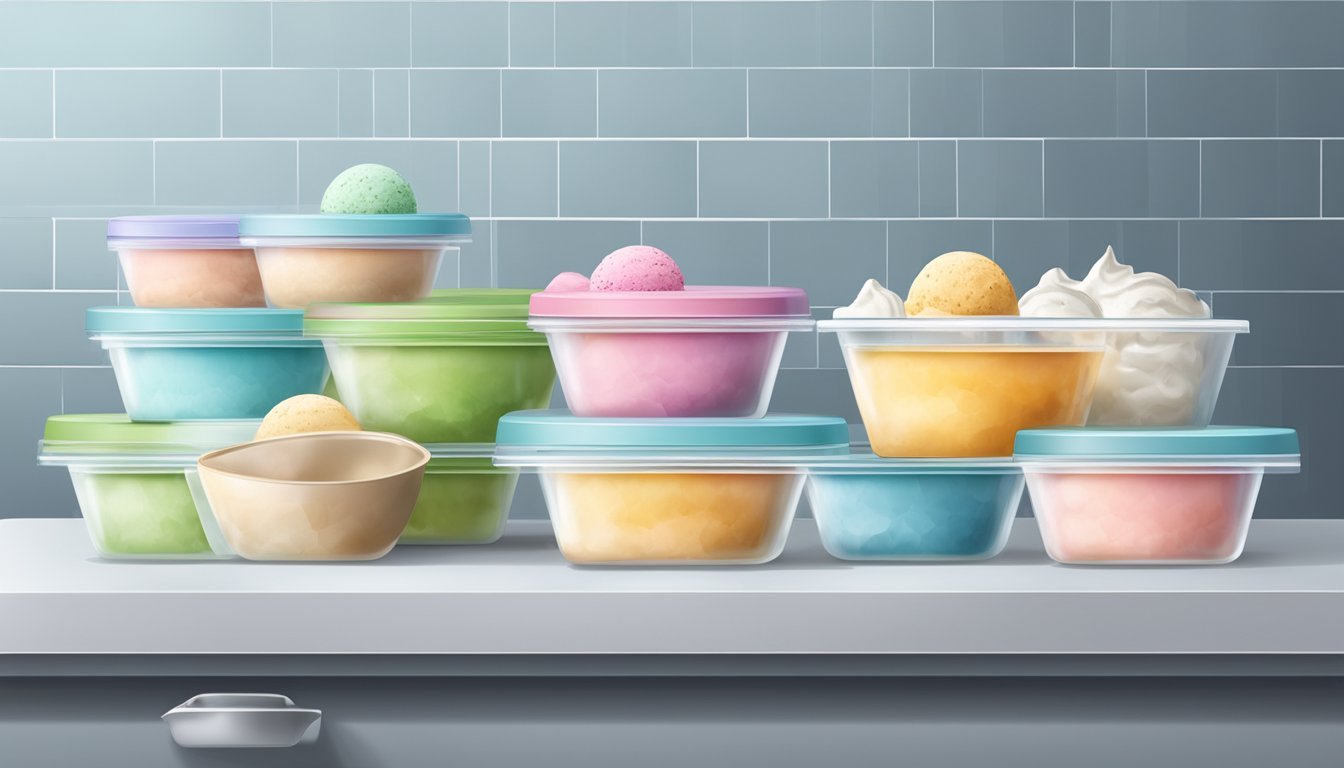How to Store and Serve Ice Cream for Best Consistency
Expert Tips for Perfect Texture
Storing and serving ice cream in a way that maintains its best texture and flavor is an art that any ice cream enthusiast or casual consumer can master with the right techniques. The key to preserving the creamy delight in its optimal state lies in understanding how temperature variability and exposure to air can degrade its quality. Proper storage involves more than just tossing a tub into the freezer; it requires strategic placement and the right container to protect the ice cream from ice crystals and flavor loss, ensuring each scoop is as satisfying as intended.
When serving ice cream, the goal is to present it with a consistency that allows for smooth scooping and a full-bodied taste that reflects the care taken in its storage. Factors such as the serving temperature and proper thawing times play significant roles in achieving the perfect balance between too hard and too melty. Employing correct serving methods not only enhances the eating experience but also showcases the respect for the carefully crafted dessert. Through intentional practices, both the integrity of ice cream's texture and the purity of its flavors can be preserved from the freezer to the bowl.
Understanding Ice Cream Storage
Proper ice cream storage hinges on maintaining stable freezer temperatures and selecting appropriate containers that minimize exposure to air.
The Importance of Stable Freezer Temperature
Ice cream's quality is preserved by storing it at a consistent temperature. The ideal range for preventing freezer burn and ensuring texture integrity is between -10ºF and -20ºF. Frequent temperature fluctuations, common near the freezer door, can cause ice cream to partially thaw and refreeze, leading to ice crystal formation and a gritty texture. For optimal consistency, position ice cream in the coldest part of the freezer, typically at the back, and away from the door.
Selecting the Proper Storage Container
Ice cream should be kept in airtight containers to prevent exposure to air, which can result in a crusty surface and the incorporation of off-flavors. Materials that offer good insulation, such as Tupperware, glass, or non-toxic plastic containers, are suitable choices. Containers with tight-fitting lids preserve flavor and maintain texture by reducing ice crystallization.
Optimizing Container Size and Shape
Choosing the right container is not just about material; size and shape also play roles. To minimize air exposure, select a container size that matches the amount of ice cream, reducing the volume of air trapped inside. Shallow containers are preferred over deep ones as they help the ice cream freeze uniformly and allow for easier scooping. Whenever possible, press a piece of plastic wrap onto the surface of the ice cream before closing the lid to further protect against air and freezer burn.
Preventing Freezer Burn and Ice Crystals
To ensure ice cream retains its creamy texture and is free from freezer burn, one must maintain the correct freezer temperature and use effective insulation techniques. These measures prevent the formation of ice crystals and a grainy texture, caused by air exposure and temperature fluctuations.
Correct Freezer Temperature Setting
The freezer should consistently be at 0°F (-18°C) or below, as this is the optimal temperature range to prevent the formation of ice crystals. Frequent temperature changes can lead to a grainy texture in ice cream. Using a freezer thermometer can help monitor the environment, ensuring it remains within this range to avoid temperature fluctuation that can cause freezer burn.
Adequate Insulation Techniques
When storing ice cream, minimizing air exposure is crucial to prevent freezer burn. One should insulate the ice cream container with materials that can act as barriers against air:
Plastic Wrap or Wax Paper: Place a sheet directly on the ice cream's surface before sealing the container. This barrier limits air contact, maintaining consistency.
Airtight Containers: Store the ice cream in airtight containers, or if the original packaging is damaged, transfer the content to a container that can be sealed tightly.
Seal the container with its original lid to further insulate it and then place the whole container in an airtight bag, squeezing out as much air as possible before sealing.
By following these methods, one can better preserve the quality and texture of their ice cream, ensuring a more enjoyable experience with each serving.
Maximizing Flavor and Texture
To ensure ice cream maintains its delightful flavor and creamy texture, one must be vigilant about storage conditions. This will prevent flavor contamination and protect the ice cream's quality.
Avoiding Flavor Contamination
Ice cream can easily absorb odors from other items in the freezer, leading to unfavorable taste alterations. To prevent flavors from mixing, one should store ice cream away from strong-smelling foods. It's advisable to place the ice cream in the coldest part of the freezer, usually at the back and towards the bottom, to maintain consistent temperature and texture.
Importance of Airtight Sealing
Airtightness is critical in preserving both flavor and texture. An airtight seal prevents air exposure that can cause ice crystals to form, resulting in a grainy texture. The lid of the ice cream container should fit snugly. For added protection, one could press a piece of plastic wrap directly onto the ice cream surface before closing the lid. This technique helps to maintain softness and deliciousness over time.
Serving Ice Cream Properly
When it comes to serving ice cream properly, the method of scooping and the technique for thawing are crucial for maintaining the perfect texture and consistency of the dessert.
The Art of Scooping
Using the correct ice cream scoop is essential for achieving perfectly rounded servings. One should opt for a sturdy scoop with a heat-conductive handle that cuts through hard ice cream more efficiently. To prevent the ice cream from sticking, running the scoop under hot water prior to use can be helpful, but one should be cautious not to overheat the scoop as it can melt the ice cream too quickly, affecting its texture.
Scooping Technique:
Dip the scoop in hot water briefly.
Wipe off any excess water to prevent melting the ice cream surface.
Enter the ice cream at a 45-degree angle and scoop with a firm, continuous motion.
Note: This technique is suitable for various types of frozen desserts, including sorbet and soft serve. It ensures portions are served at their finest consistency without stressing the product.
Thawing to Ideal Consistency
For optimal scooping, ice cream should be thawed to a temperature where it can be served easily but maintains its structure. This means allowing the ice cream to sit at room temperature for a few minutes before serving.
Thawing Steps:
Place the ice cream container on the counter for about 3-5 minutes prior to serving.
Ensure the container is tightly closed while it tempers to prevent moisture loss.
Check the consistency; it should yield slightly to the scoop.
Caution: Avoid using the microwave to expedite thawing as this can unevenly soften the ice cream and lead to a compromised texture. A gentle room temperature thaw maintains the quality of the ice cream.
Special Considerations for Homemade Ice Cream
Storing homemade ice cream effectively requires understanding the nuances of freezing and long-term storage to maintain its best consistency and flavor.
Proper Freezing Techniques
After churning ice cream in an ice cream maker, it's crucial that one transfers it to a pre-chilled container to expedite the freezing process. Shallow, flat containers are preferred for their ability to freeze ice cream evenly, reducing the risk of ice crystal formation. For those incorporating fresh fruit or mix-ins into their recipe, thorough blending before freezing ensures uniform distribution throughout the ice cream.
Initial Freeze: Swiftly transfer to a freezer-safe container and smooth the top.
Temperature: Maintain the freezer at -18°C (0°F) or below.
Isolation: Place in the back of the freezer, away from the door, to minimize temperature fluctuations.
Tips for Long-Term Storage
The shelf life of homemade ice cream is influenced by how it's stored. To preserve homemade ice cream's texture and prevent freezer burn, one should use airtight storage containers. Wrapping the container in a plastic wrap before sealing the lid can provide an additional barrier against air.
Airtight Containers: Use freezer-safe containers with tight-fitting lids.
Labeling: Clearly label containers with the recipe name and the date of freezing.
Containers can be stacked to maximize freezer space, but avoid overcrowding which can hinder proper air circulation.
Safety and Hygiene in Ice Cream Storage
When storing ice cream, attention to bacterial growth and avoiding cross-contamination is essential for maintaining food safety and ensuring a high-quality product.
Mitigating Bacterial Growth
To mitigate bacterial growth in ice cream, one should:
Store at consistent low temperatures: Ice cream should be kept at a steady temperature range between -5°F and 0°F to prevent the formation of ice crystals and bacterial growth.
Regular Maintenance: Equipment used for dispensing ice cream must be cleaned and disinfected regularly. Following the manufacturer's guidelines and using food-safe cleaning agents ensures harmful bacteria do not contaminate the ice cream.
Avoiding Cross-Contamination
In preventing cross-contamination:
Use Separate Utensils: Different flavors or types of ice cream should be handled with separate utensils to prevent flavor and bacterial cross-contamination.
Proper Scooping Technique: Avoid wetting the ice cream scoop with warm or hot water as it can lead to the outer layer melting and becoming susceptible to bacterial contamination. Use a scoop cleaned under cold water and sanitized regularly.
Practical Tips for Buying and Storing
When purchasing and storing ice cream, the choice of containers and practices post-opening can greatly influence the ice cream's consistency and longevity.
Choosing Containers at Purchase
Material: It's best for the buyer to look for ice cream sold in airtight containers — preferably made of durable materials that can withstand low temperatures without cracking.
Lid Quality: One should ensure the container comes with a secure-fitting lid, which is crucial in maintaining an airtight environment and safeguarding the content from freezer burn.
Ice Cream Storage After Opening
Avoid the Freezer Door: Once opened, ice cream should be stored away from the freezer door to minimize exposure to warm air which can cause fluctuations in temperature.
Airtight Seal: To maintain quality, one should transfer the ice cream to an airtight container if the original packaging isn't resealable. Carefully smooth out the surface of the ice cream and press a piece of wax paper against it before closing the lid to minimize ice crystal formation.




